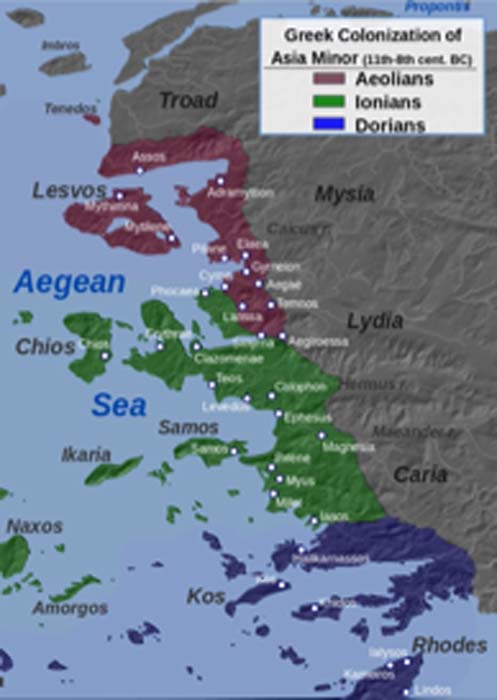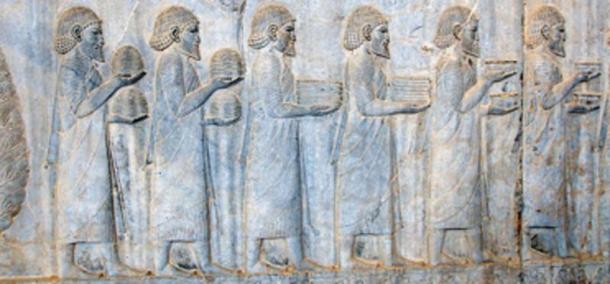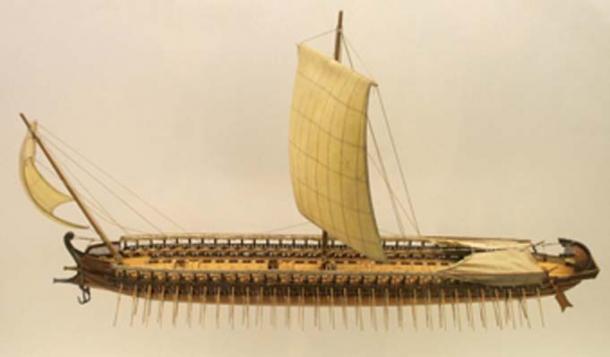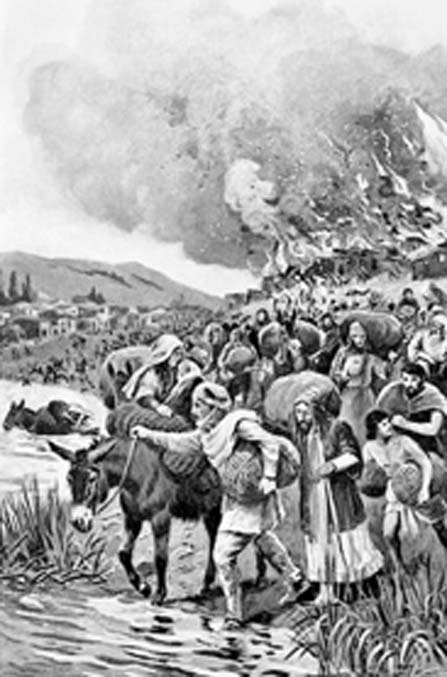
The Ionian Revolt - Prelude to the Graeco-Persian Wars
The Ionian Revolt was a series of revolts that broke out in Asia Minor at the beginning of the 5th century BC. At that time, the whole of Asia Minor was under the rule of the Achaemenid Empire. The central part of the region’s west coast was known as Ionia.
The Ionians were Greeks who had settled in that part of Asia Minor around the end of the 2nd / beginning of the 1st millennium BC. Ionia was conquered by the Achaemenids during the 6th century and became one of the empire’s satrapies.
At the beginning of the 5th century, the Ionians revolted against Persian rule. The rebels obtained some help from Athens and Eretria, though not much. Nevertheless, the little aid provided by the Greeks to the Ionians angered Darius I, the Achaemenid ruler at that time.
Shortly after the revolt in Asia Minor was crushed, Darius I invaded Greece. Thus, the Ionian Revolt may be considered to be the prelude to the Graeco-Persian Wars, which would last until the middle of the 5th century BC.
The Ionians Form Settlements
Around 11th century BC, the Ionian tribal group left their homeland in Greece to settle on the west coast of Asia Minor. The Ionians, incidentally, were not the only Greek group to migrate there, as the Aeolians and Dorians were doing the same thing. The Ionians settled in the area between the Gulf of Smyrna (known today as Izmir) and the Gulf of Mandalya (also known as the Güllük Gulf).

Greek Colonization of western Asia Minor. (Alexikoua / CC BY-SA 3.0)
Initially, there were many small Ionian settlements in the area. By the 8th century BC, however, the Ionians had settled along the entire coastline, and organized themselves into 12 major cities – Phocaea, Erythrae, Clazomenae, Teos, Lebedus, Colophon, Ephesus, Priene, Myus, Miletus, Chios, and Samos.
The first 10 cities were located on the mainland, while the other two were on islands. The Ionian cities were independent of each other. Nevertheless, recognizing their shared cultural heritage, the Ionians established the Panionium, which was a sanctuary dedicated to Poseidon Helikonios, as a place where they could meet.
The Ionians made some important contributions to Greek civilization, one of which being early Greek philosophy and science. The Ionian city of Miletus is regarded to be the birth place of Western philosophy, as it was here that the first philosopher, Thales of Miletus, is recorded to have lived.
Thales, Anaximander, and Anaximenes (the former a pupil of Thales and the latter a pupil of Anaximander) formed the Milesian school, which flourished during the 7th century BC. Other early philosophers from Ionia include Xenophanes of Colophon, Pythagoras of Samos, and Heraclitus of Ephesus.
In addition to being a center of intellectual activity, Ionia was also a thriving trade hub. During the 6th century BC, Miletus and Phocaea were setting up colonies along the coast of the Black Sea, as well as the Mediterranean coast of France and Spain. Thanks to trade, the Ionian cities prospered.
The Growth of the Ionians
Ionian exploration of overseas land was not only spurred on by trade ambitions but was also undertaken out of necessity. As the Ionian cities expanded, more land was needed to support the growing population. Naturally, the Ionians moved further inland, though this brought them into conflict with the powerful kingdom of Lydia.
Ultimately, the Ionian cities on the mainland fell one by one to the Lydians, and the conquest of Ionia was completed during the reign of Croesus. The Lydians, however, were unable to conquer the cities of the Ionian islands, due to a lack of a naval force, and therefore were forced to form alliances with them.
Lydian control over Ionia did not last for long. To the west of Lydia was the Achaemenid Empire, which, having defeated the Medes in 550 BC, turned their attention to the west. Croesus decided to deal with this threat by striking at the Achaemenids first.
In 547 BC, he invaded Cappadocia and an inconclusive battle was fought at Pteria. Croesus was forced to return to his capital, Sardis, but unbeknownst to him, he was being pursued by the Persian army. As a consequence, Cyrus the Great took Croesus completely by surprise and captured Sardis in 546 BC.
Ionia Becomes Part of the Achaemenid Empire
The defeat of Croesus and the destruction of Lydia meant that Ionia was now part of the Achaemenid Empire. Furthermore, the Ionians themselves were unable to put up any resistance and therefore had no choice but to accept their absorption into the Achaemenid Empire.
In the decades that followed, Ionia was ruled as a satrapy of the Achaemenid Empire and was required to pay tribute. According to Herodotus, “the Ionians, Asian Magnesians, Aeolians, Carians, Lycians, Milyans, and Pamphylians, were assessed as a single unit … 400 talents of silver”.
- Ancient Fort and Stele Proclaiming Victory of Famous Persian King Found in Russia
- The quest to recover the fallen soldiers of Marathon
- Thucydides Gave Amazing Insight into War That Shook The Aegean World for Decades

Ionian tribute bearers on the Apadana staircase. (Magnus Manske / CC BY-SA 2.0)
It is unclear as to the cause of the Ionian Revolt and several plausible reasons have been put forward. One of the most common reasons given is that the Ionians grew increasingly discontent with Achaemenid rule, and that they were no longer willing to pay the tribute that was forced upon them.
Another reason given is that the tyrant of Miletus, Aristagoras, wanted to escape punishment from Artaphernes, the satrap of Lydia, following his failure to conquer Naxos. In 499 BC, Aristagoras received some rich inhabitants of Naxos who had been kicked out of the island by their compatriots. They hoped to return home and therefore sought the help of the tyrant.
Aristagoras saw this as an opportunity to conquer the wealthy island on behalf of the Achaemenid Empire. Agreeing to help the refugees, Aristagoras requested military aid from Artaphernes and was granted a fleet of 200 ships, under the command of Megabates, a cousin of Darius. Instead of sailing directly for Naxos, however, the commanders decided to take the fleet in the opposite direction, i.e. towards the Hellespont, hoping that they could take the Naxians by surprise.
The fleet stopped at Chios for a month, while waiting for a north wind to blow them southwards. During this time, Megabates inspected the ships and finding one neglected ordered the commander to be punished. Aristagoras intervened, freeing the commander, and reminded Megabates that he was only second-in-command.
As a consequence, the relation between the two men soured. Megabates retaliated by sabotaging the mission, sending a warning to the Naxians about the impending invasion.
The Naxians made the necessary preparations and therefore were able to resist the four-month long siege by Aristagoras. In the end, the tyrant of Miletus was forced to abandon the siege and the Naxians placed themselves in forts around the island.
When he returned home, Aristagoras was fearful that his failed campaign against the Naxians would raise the ire of his superiors, and that he would be severely punished by Artaphernes. Around the same time, the former tyrant of Miletus, Histiaeus (who was also the uncle of Aristagoras), sent a message to his nephew urging him to revolt.
Seeds of Revolt
According to Herodotus, Histiaeus tattooed the message on the scalp of a slave, waited for his hair to grow back, and sent him to Miletus. Once the slave was received by Aristagoras, he had his head shaved, thus revealing Histiaeus’ secret message.
Herodotus also reports that the former tyrant wanted a revolt to break out in Ionia because he was tired of being held as a captive (albeit an honored one) in Susa, the Persian capital. Histiaeus was hoping that when a revolt was to break out in Ionia, in particular his home city of Miletus, he would be sent back there.
Having received Histiaeus’ secret message, and considering his own problems with the Achaemenids, Aristagoras held a council with his supporters and decided to revolt against the Persians. One of Aristagoras’ supporters, Hecataeus, urged him not to revolt, as the Persians were too powerful. When he failed to persuade Aristagoras, Hecataeus recommended that they should not fight against Darius on land, but to try to gain control of the sea.
Moreover, he suggested that the rebels seize the sanctuary at Branchidae, where all the valuable property of Croesus had been stockpiled. This would give Aristagoras the money needed to sustain the revolt. Aristagoras, however, ignored Hecataeus’ advice.
The Beginning of the Ionian Revolt
The first thing that Aristagoras did was to dispatch Iatragoras to Myous, where the expeditionary force had stopped after the campaign against Naxos, in order to take control of the fleet. Iatragoras succeeded in his mission by capturing the commanders of the ships through trickery. Thus, the rebels gained possession of the fleet and its troops.
Aristagoras’ next step was to relinquish his position as tyrant, and to convert Miletus into a democracy. By doing so, Aristagoras hoped that the citizens of Miletus would voluntarily join the revolt, so as to defend their freedom.

Location and main events of the Ionian Revolt. (AnonMoos / CC BY-SA 3.0)
Aristagoras proceeded to depose the other tyrants of Ionia, so as to gain the support of the rest of the Ionians. Furthermore, Aristagoras sought military aid from the Greeks, as he was aware that the Ionians were not strong enough to fight the Achaemenids on their own.
Aristagoras went first to the Spartans, as it was the most powerful state in Greece at that time. Unfortunately, Aristagoras failed to convince their king, Cleomenes, to send help and was even thrown out of the state. Next he went to Athens, the second most powerful Greek state, where he presented his case to the citizens of Athens.
The Ionian Revolt Gets Support
This was the exact opposite as in Sparta, where Aristagoras could only present his case to one individual, i.e. Cleomenes. Aristagoras fared much better with the Athenians, who voted to send 20 ships to aid the Ionians. Herodotus considers this small fleet to be “the beginning of misfortune for Greeks and non-Greeks alike.”
Aristagoras also managed to obtain five ships from Eretria. The Eretrians were repaying a debt to the Milesians, as the latter had aided the former during their war against the Chalcidians.

Reconstructed model of a trireme, the type of ship in use by both the Greek and Persian forces. (Sting / CC BY-SA 3.0)
Once he returned to Miletus, Aristagoras gathered his forces and launched an attack on Sardis in 498 BC. The rebels took the Persians by surprise and defeated them. Most of Sardis was burned down, but the satrap, Artaphernes, managed to defend the citadel. The Persians soon launched a counter-attack and the rebels were forced to retreat from Sardis.
The Persian forces caught up with the rebels, who were retreating back to Ephesus and soundly defeated them. After this defeat, the Athenians returned home and the Eretrians, whose commander was killed during the battle, probably did so as well.
This was the only major land offensive launched by the Ionians during the revolt. After the attack on Sardis, the Ionians concentrated their war efforts near the coast.
- The Plurality of the Persian Empire: Part I – The Achaemenids to the Sassanians
- Striking Grave Goods Begin to Shed Light on Hellenistic Life in Turkey
- The Master Archers of the Powerful Achaemenid Empire

The burning of Sardis by the Greeks during the Ionian Revolt in 498 BC. (पाटलिपुत्र / Public Domain)
The Ionian Revolt Grows
The Ionian Revolt spilled over to neighboring areas and Byzantium, Caria, Caunus, and most of Cyprus joined the rebels. It was the revolt in Cyprus, led by Onesilus, the king of Salamis, that alarmed Darius the most. This was due to the fact that if Cyprus was lost to the rebels, the sea route to Egypt would be cut off, and would leave Phoenicia vulnerable to attacks.

Darius the Great was alarmed by the Ionian Revolt. (Nick Thompson / CC BY-SA 2.0)
Therefore, in 497 BC, the Persians assembled a fleet and an army to take Cyprus back from the rebels. Although the Ionians sent a fleet to aid the Cypriots, the island soon returned to Achaemenid control, as Onesilus was slain on the battlefield.
The rebellion by the Carians also played a significant part in the Ionian revolt. In 496 BC, the Persians under Daurises, the son-in-law of Darius, defeated the Carians at the Battle of Marsyas and the Battle of Labraunda. The Carians, whose numbers had been significantly reduced, resolved to fight on rather than surrender, and set a trap for Daurises on the road to Pedasus.
During the Battle of Pedasus, Daurises and the other Persian forces were slain, and their army annihilated. As a consequence, Darius temporarily halted military action against the Ionians, and the year 495 BC passed relatively peacefully.
The Persians Crush the Ionian Revolt
By 494 BC, however, the Persians were ready once more to launch a large-scale offensive against the Ionians. Their goal was to capture Miletus, the center of the revolt. It may be mentioned that by this time, the revolt was effectively leaderless, as Aristagoras had died in 497/6 BC.

Ruins of Miletus, center of the Ionian Revolt. (Guy Beauchamp / CC BY-SA 2.0)
As the Achaemenid counter-offensive following their defeat at Sardis was beginning to bear fruit, Aristagoras decided to abandon his role as leader of the revolt and to flee to Thrace, he was killed there during a campaign against the Thracians. In 494 BC, the Persians defeated the Ionian fleet at the Battle of Lade, after which Miletus was besieged and taken. By 493 BC, the Persians had completed their brutal reconquest of Ionia and the Ionian Revolt came to an end.
Although Ionia was once again part of the Achaemenid Empire, Darius had not forgotten the aid provided by Athens and Eretria to the rebels. The Achaemenid ruler intended to punish the Greeks for what they had done.
In 492 BC, a year after the end of the Ionian Revolt, Darius launched a military campaign against the Greek mainland. Thus, the Ionian Revolt has been considered to be the starting point of the Graeco-Persian Wars, which lasted for about half a century.
Top image: The Ionians were Greeks who revolted against the Achaemenid Empire in Asia Minor. Source: Fernando Cortés / Adobe Stock.
By Wu Mingren
References
About History. 2018. Ionian Revolt 499-493 BC. about-history.com. [Online] Available at: https://about-history.com/ionian-revolt-499-493-bc/
Badian, E. 2012. Ionian Revolt. Encyclopaedia Iranica. [Online] Available at: http://www.iranicaonline.org/articles/ionian-revolt
Dzhak, Y. 2016. The Ionian Revolt and the Battle of Marathon – First Greek-Persian War. [Online] Available at: https://www.warhistoryonline.com/ancient-history/ionian-revolt-battle-ma...
Gill, N. 2018. The Beginning of the Ionian Revolt. [Online] Available at: https://www.thoughtco.com/beginning-of-the-ionian-revolt-121458
McKirahan, R. 2010. Philosophy Before Socrates. Hackett Publishing Company, Inc.
Nielsen, L. Date Unknown. The Ionian Revolt. OSU.edu. [Online] Available at: https://ehistory.osu.edu/articles/ionian-revolt
Rickard, J. 2015. Ionian Revolt, 499-493 BC. [Online] Available at: http://www.historyofwar.org/articles/wars_ionian_revolt.html
Rickard, J. 2015. Siege of Naxos, 499 BC. [Online] Available at: http://www.historyofwar.org/articles/siege_naxos_499.html
Sansal, B. Date Unknown. Ionian civilization. [Online] Available at: http://www.allaboutturkey.com/ion.htm
The Editors of Encyclopaedia Britannica. 2012. Ionia. [Online] Available at: https://www.britannica.com/place/Ionia
The Editors of Encyclopaedia Britannica. 2017. Ionian Revolt. [Online] Available at: https://www.britannica.com/event/Ionian-revolt
The Editors of Encyclopaedia Britannica. 2019. Croesus. [Online] Available at: https://www.britannica.com/biography/Croesus
The Editors of Encyclopaedia Britannica. 2019. Greco-Persian Wars. [Online] Available at: https://www.britannica.com/event/Greco-Persian-Wars
Waterfield, R. 1998. Herodotus, The Histories (translated). Oxford University Press.















